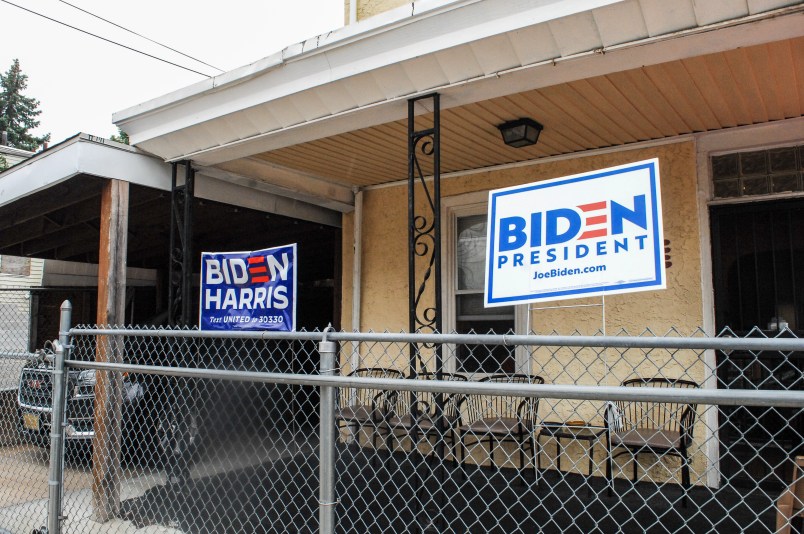Democratically-aligned groups are doing autopsies on what went wrong in 2020 — or, perhaps more accurately, what didn’t go right enough — as they face the looming 2022 election cycle.
The President’s party usually loses seats in its first midterm elections, and Democrats got trounced shortly after they achieved their last two trifectas in 1993 and 2009. With achingly thin margins in both the House and the Senate, Democrats can’t afford to allow even a mild red wave next year.
That historical precedent has Democrats looking in the rearview, diagnosing problems with both advertising and polling from the last election cycle.
TV ad spending isn’t working well — go digital instead.
A memo from Priorities USA, a major Democratic Super PAC, highlights the wasted dollars spent on TV ads last cycle, many of which were shown to people who’d already voted early. The group also found that 75 percent of TV ads in House races aired outside the district they intended to target.
“The current House battleground has shifted to focus primarily on suburban and exurban districts,” the memo said. “This means the districts are typically in larger media markets and make up a much smaller share of the [media market] than a decade ago when more rural districts that made up entire media markets were in play.”
The group advises a shift to digital advertising, a more sharply targeted method that occupies the space where Americans are increasingly spending most of their time. They found that while Americans spend about 2 more hours of their day with digital media rather than traditional media, Democrats invested 77 percent of their spending in the latter.
People are voting earlier. Fundraising and advertising timelines need to reflect that.
Priorities found that 10 percent of Democrats’ total ad budget was likely wasted on people who had already voted. In the 2020 cycle, when voters were especially likely to vote early by mail amid the pandemic, the group calculated that the percentage translated to roughly $334 million down the tubes.
The group encourages earlier investment to nab those voters before they lick the stamp — with a dark asterisk.
“Strategies should be flexible to reflect the changing legislative and legal landscape around voting rights,” the memo reads.
Republican-controlled legislatures across the country are unveiling restrictive voter legislation, much of which makes it harder to vote absentee.
Polls again underestimated turnout among low propensity Republicans.
While Priorities USA sorted through the advertising data, a group of Democratic pollsters released an analysis of what went wrong in their 2020 projections.
There were more questions than answers about why polling seems to miss so big especially in elections when former President Donald Trump was on the ballot. But one thing they know for sure: they underestimated the turnout of Republicans who don’t usually vote by significant margins.
“Among low propensity voters—people who we expect to vote rarely—the Republican share of the electorate exceeded expectations at four times the rate of the Democratic share,” the report said. “This turnout error meant, at least in some places, we again underestimated relative turnout among rural and white non-college voters, who are overrepresented among low propensity Republicans.”
COVID theory: perhaps people who were being more cautious about the pandemic and thus staying home were easier for pollsters to reach.
As the pollsters try to divine why they keep missing Trump voters, they hypothesized that the pandemic played a role. Perhaps people more inclined to take the COVID-19 pandemic very seriously, a group Trump helped ensure was more Democratic as he resolutely downplayed the danger, were easier to reach as they quarantined at home, and, as a result, were more likely to speak with pollsters.
They also mention Trump voters’ low social trust as a possible contributor to their omission from the polls. Trump voters may simply be less likely to trust and thus engage with pollsters when they call.
Fear of overcorrecting when the most pronounced polling error seems linked to Trump being on the ballot.
Even while the pollsters plumbed the depths of potential factors in the polling misses, they were quick to warn of the dangers of overcorrecting. The polling misses were most pronounced in 2016 and 2020 — when Trump was on the ballot.
“We have to realize polling error has been far more pronounced in presidential elections, especially those with Donald Trump on the ballot, so we should be careful not to overcorrect for an error that may be geared to one man who will, hopefully, never be on the ballot again,” the analysis said.







The word “hopefully” is doing a lot of work in that sentence…
Here’s what I see looking forward - if we don’t deal with Manchin, we are going to get slaughtered in 2022.
Bingo. If G.O.P. fuckery at the State level can’t be stopped by Federal legislation, we’re doomed. And if the filibuster lives, the needed legislation doesn’t get passed. And if no one reads Manchin the Riot Act, the Senate Republicans are going to do everything in their power to maintain their power, and to make Biden look like a failure. Finally, the judiciary, packed with Federalist Society hacks, is of no use to us.
I think it’s a lot simpler than that. Trump voters themselves always say they’ll never tell the truth to a pollster
[“Hopefully there will be some sort of truce,” Senate Minority Whip John Thune told Politico in a piece published last night. “It’s in everybody’s best interest — including the former president, if he wants to continue to stay viable politically — to help us win the majority in 2022. And that means working with Senate Republicans, and not against them.”]
From Josh’s essay today…
There are too many unknown variables, the majority of which have to do with Law Enforcement…Trump is awash with legal problems